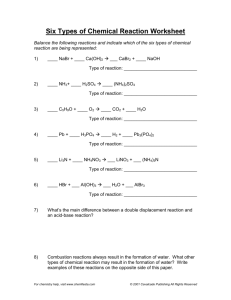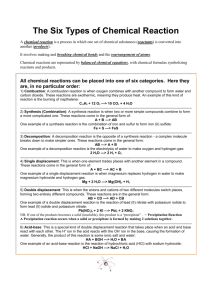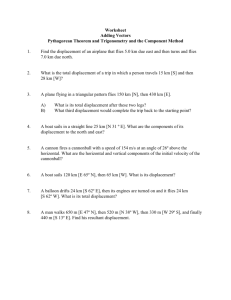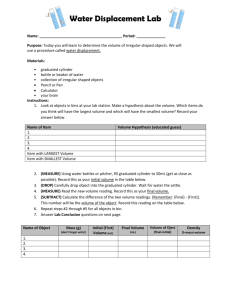Types of Chemical Reactions Part 2
advertisement
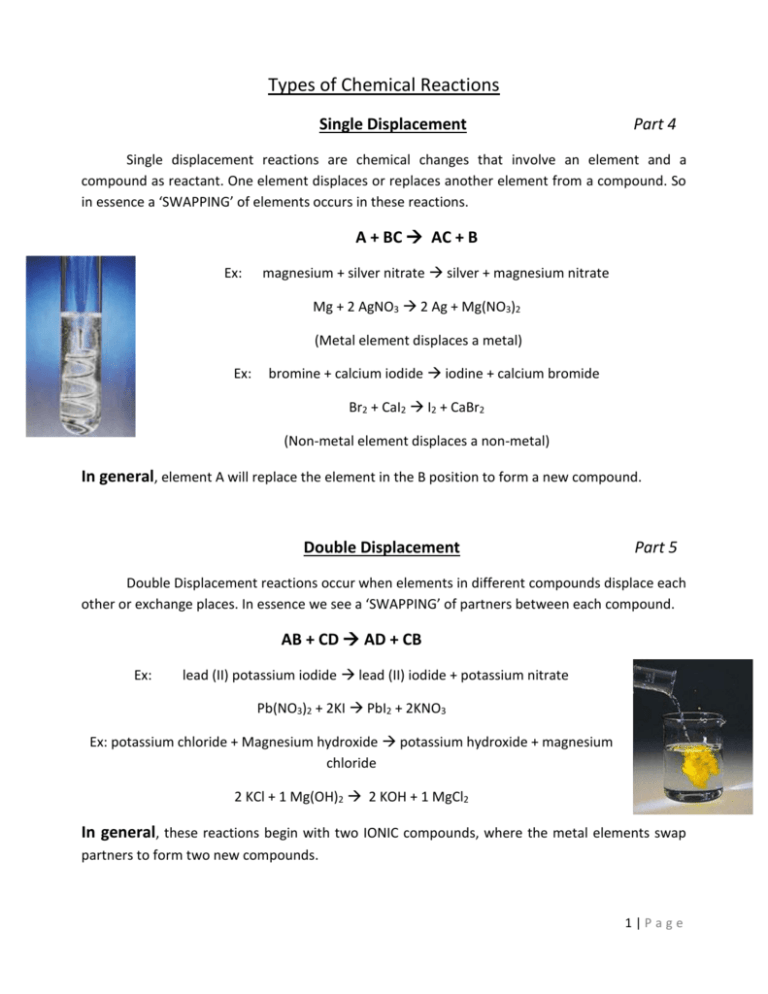
Types of Chemical Reactions Single Displacement Part 4 Single displacement reactions are chemical changes that involve an element and a compound as reactant. One element displaces or replaces another element from a compound. So in essence a ‘SWAPPING’ of elements occurs in these reactions. A + BC AC + B Ex: magnesium + silver nitrate silver + magnesium nitrate Mg + 2 AgNO3 2 Ag + Mg(NO3)2 (Metal element displaces a metal) Ex: bromine + calcium iodide iodine + calcium bromide Br2 + CaI2 I2 + CaBr2 (Non-metal element displaces a non-metal) In general, element A will replace the element in the B position to form a new compound. Double Displacement Part 5 Double Displacement reactions occur when elements in different compounds displace each other or exchange places. In essence we see a ‘SWAPPING’ of partners between each compound. AB + CD AD + CB Ex: lead (II) potassium iodide lead (II) iodide + potassium nitrate Pb(NO3)2 + 2KI PbI2 + 2KNO3 Ex: potassium chloride + Magnesium hydroxide potassium hydroxide + magnesium chloride 2 KCl + 1 Mg(OH)2 2 KOH + 1 MgCl2 In general, these reactions begin with two IONIC compounds, where the metal elements swap partners to form two new compounds. 1|Page Types of Chemical Reaction Worksheet Balance the reactions a to f and indicate which types of chemical reaction are being represented: a) ____ NaBr + ____ Ca(OH)2 ___ CaBr2 + ____ NaOH Reaction Type : ______________ b) ____ NH3+ ____ H2SO4 ____ (NH4)2SO4 Reaction Type : ______________ c) ____ C5H9O + ____ O2 ____ CO2 + ____ H2O Reaction Type : ______________ d) ____ Pb + ____ H3PO4 ____ H2 + ____ Pb3(PO4)2 Reaction Type : ______________ e) ____ Li3N + ____ NH4NO3 ___ LiNO3 + ___ (NH4)3N Reaction Type : ______________ f) Na3PO4 + 3 KOH 3 NaOH + K3PO4 Reaction Type _______________________ g) MgCl2 + Li2CO3 MgCO3 + 2 LiCl Reaction Type _______________________ h) C6H12 + 9 O2 6 CO2 + 6 H2O Reaction Type _______________________ i) Pb + FeSO4 PbSO4 + Fe Reaction Type _______________________ j) CaCO3 CaO + CO2 Reaction Type _______________________ k) P4 + 3 O2 2 P2O3 Reaction Type _______________________ l) 2 RbNO3 + BeF2 Be(NO3)2 + 2 RbF Reaction Type _______________________ m) 2 AgNO3 + Cu Cu(NO3)2 + 2 Ag Reaction Type _______________________ n) C3H6O + 4 O2 3 CO2 + 3 H2O Reaction Type _______________________ o) 2 C5H5 + Fe Fe(C5H5)2 Reaction Type _______________________ p) SeCl6 + O2 SeO2 + 3Cl2 Reaction Type _______________________ q) 2 MgI2 + Mn(SO3)2 2 MgSO3 + MnI4 Reaction Type _______________________ r) O3 O. + O2 Reaction Type _______________________ s) 2 NO2 2 O2 + N2 Reaction Type _______________________ 2|Page Predicting the products of chemical reactions Predict the products of the following reactions: 1) __ Ag + __CuSO4 Type:___________________________ 2) __ NaI + __ CaCl2 Type:___________________________ 3) __ O2 + __ H2 Type:___________________________ 4) __ AgNO2 + __ BaSO4 Type:___________________________ 5) __ HCN + __ CuSO4 Type:___________________________ 6) __ H2O + __ AgI Type:___________________________ 7) __ LiBr + __ Co(SO3)2 Type:___________________________ 8) __ LiNO3 + __Ag Type:___________________________ 9) __ N2 + __ O2 Type:___________________________ 10) __ H2CO3 Type:___________________________ 11) __ AlCl3 + __ Cs Type:___________________________ 12) __ Al(NO3)3 + __ Ga Type:___________________________ 3|Page Six Types of Chemical Reaction Worksheet Answers Balance the following reactions and indicate which of the six types of chemical reaction are being represented: a) 2 NaBr + 1 Ca(OH)2 1 CaBr2 + 2 NaOH Type of reaction: double displacement b) 2 NH3+ 1 H2SO4 1 (NH4)2SO4 Type of reaction: synthesis c) 4 C5H9O + 27 O2 20 CO2 + 18 H2O Type of reaction: combustion d) 3 Pb + 2 H3PO4 3 H2 + 1 Pb3(PO4)2 Type of reaction: single displacement e) 1 Li3N + 3 NH4NO3 3 LiNO3 + 1 (NH4)3N Type of reaction: double displacement f) 3 HBr + 1 Al(OH)3 3 H2O + 1 AlBr3 Type of reaction: acid-base Section 3: Predicting the products of chemical reactions 1) 2 Ag + 1 CuSO4 1 Ag2SO4 + 1 Cu Type: Single Displacement 2) 2 NaI + 1 CaCl2 2 NaCl + 1 CaI2 Type: Double Displacement 3) 1 O2 + 1 H2 2 H2O Type: Synthesis 4) 2 AgNO2 + 1 BaSO4 1 Ag2SO4 + 1 Ba(NO2)2 Type: Double Displacement 5) 2 HCN + 1 CuSO4 1 H2SO4 + 1 Cu(CN)2 Type: Double Displacement 6) 1 H2O + 1 AgI 1 HI + 1 AgOH Type: Double Displacement 7) 4 LiBr + 1 Co(SO3)2 2 Li2SO3 + 1 CoBr4 Type: Double Displacement 8) 1 LiNO3 + 1 Ag 1 AgNO3 + 1 Li Type: Single Displacement 9) 1 N2 + 2 O2 2 NO2 Type: Synthesis 10) 1 H2CO3 1 CO2 + 1 H2O Type: Decomposition 11) 1 AlCl3 + 3 Cs 3 CsCl + 1 Al Type: Single Displacement 12) 1 Al(NO3)3 + 1 Ga 1 Ga(NO3)3 + 1 Al Type: Single Displacement 4|Page 13) 1 CH3COOH + 1 O2 1 CO2 + 2 H2O Type: Combustion 14) 1 C4H8 + 6 O2 4 CO2 + 4 H2O Type: Combustion 15) 2 KCl + 1 Mg(OH)2 2 KOH + 1 MgCl2 Type: Double Displacement 16) 1 Zn + 1 Au(NO2)2 1 Zn(NO2)2 + 1 Au Type: Single Displacement 17) 1 BaS + 1 PtCl2 1 BaCl2 + 1 PtS Type: Double Displacement 18) 2 Na2O 4 Na + 1 O2 Type: Decomposition 13) __ CH3COOH + __ O2 Type:___________________________ 14) __ C4H8 + __ O2 Type:___________________________ 15) __ KCl + __ Mg(OH)2 Type:___________________________ 16) __ Zn + __ Au(NO2)2 Type:___________________________ 17) __ BaS + __ PtCl2 Type:___________________________ 18) __ Na2O Type:___________________________ 5|Page

